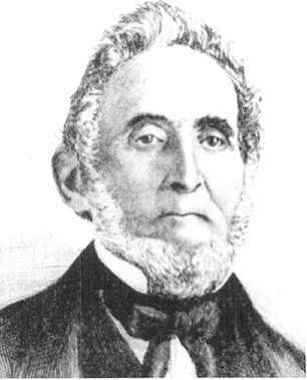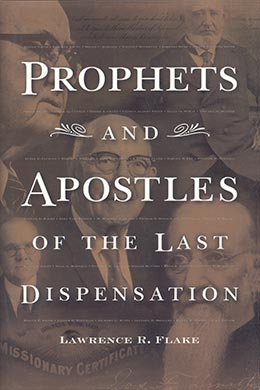Sidney Rigdon
Lawrence R. Flake, Prophets and Apostles of the Last Dispensation (Provo, UT: Religious Studies Center, Brigham Young University, 2001), 165–68.

Born: 19 February 1793, Saint Clair, Pennsylvania
Second counselor to President Joseph Smith: 8 March 1832 (age 39)
First counselor to President Joseph Smith: 18 March 1833 to 27 June 1844
Excommunicated: 8 September 1844
Died: 14 July 1876 (age 83), Friendship, New York
On 16 February 1832, in a farm house in Hiram, Ohio, the Prophet Joseph Smith and his scribe Sidney Rigdon pored over the pages of the King James Bible. They were engaged under the command of the Lord in correcting errors and omissions in the sacred writings. The Prophet recorded, “While we were doing the work of translation which the Lord had appointed unto us, we came to the twenty-ninth verse of the fifth chapter of John” (D&C 76:15). When the Spirit revealed the true meaning of this verse, Joseph and Sidney marvelled at the profound implications. Suddenly a great vision was opened to these two men: “And while we meditated upon these things, the Lord touched the eyes of our understanding and they were opened” (D&C 76:19).
The details of this vision, which lasted more than an hour, were marvelous—they beheld Satan and the hosts of heaven weeping over his fall; they beheld the brilliance of the celestial kingdom, the moonlike light of the terrestrial kingdom, the twinkling starlike quality of the telestial kingdom, and even the glory of the Son on the right hand of the Father. There were a number of other brethren in the room who “saw the glory and felt the power, but did not see the vision.” [1] These brethren reported that Joseph Smith, the seer, sat calmly in the midst of all this glory, but that Sidney Rigdon became pale and limp at its overwhelming nature. Joseph smilingly said, “Brother Sidney is not as used to it as I am!” [2] The diligent scribe stayed awake all night to write the vision as the voice of the Lord had commanded.
Sidney was a man blessed of the Lord and close to the Prophet. Before joining the Church, he had established a reputation as a successful preacher in Pittsburgh. Reverend Rigdon was so loved by his congregation that when he announced he could no longer teach the doctrine of the Baptist church, specifically infant damnation, and that he therefore could no longer continue as their preacher, the people were filled with sorrow and even shed tears. From Pittsburgh, Sidney moved to Mantua, Ohio, where he allied himself with the teachings of Alexander Campbell and built up a large congregation of Campbellites. After about a year, some residents of the nearby town of Mentor, who had also become disenchanted with the Baptist faith, importuned Reverend Rigdon to come to their city and become their preacher. He complied with this request and became very popular in that area.
In the fall of 1830 Elder Parley P. Pratt, a young man whom Sidney had known previously, and three other missionaries stopped by Mr. Rigdon’s house on their way to preach the gospel to the Indians in Missouri. They introduced him to the Book of Mormon. Although skeptical at first, Sidney allowed the missionaries to preach to his congregation. He scrutinized the book for two weeks. After much prayer and study, he concluded that the record was true, and he was baptized. Shortly thereafter Brother Rigdon moved to Fayette, New York, where he met Joseph Smith and began an association with him that lasted until the Prophet’s martyrdom fourteen years later.
Elder Rigdon was in the forefront of the persecution faced by the Church. In Hiram, Ohio, when the Prophet was tarred and feathered, Sidney was also dragged from his home across the frozen ground, tarred, feathered, beaten, and left for dead. When apostasy racked the Church in Kirtland in 1837, Sidney Rigdon remained faithful to the Prophet and moved his family to Missouri, where he presided over the stake at Adam-ondi-Ahman. Betrayed, along with the Prophet, into the hands of the enemy at the fall of Far West, Sidney spent many agonizing months in Liberty Jail. Escaping with his brethren from the clutches of the persecutors, he traveled to Illinois and helped establish the city of Nauvoo.
On 8 March 1832 the Prophet Joseph Smith recorded: “Chose this day and ordained Brother Jesse Gause and Broth[er] Sidney [Rigdon] to be my councellers of the ministry of the presidency of th[e] high Pri[e]sthood.” [3] A year later Brother Rigdon was designated as first counselor to Joseph Smith in the presidency of the Church and continued to serve with great zeal. However, in Nauvoo his enthusiasm seemed to wane. The Prophet suspected Sidney of being involved in a plot against him—a plot spearheaded by John C. Bennett. This mistrust and other disappointments in Sidney led the Prophet to ask the Church to release him from the First Presidency. Because of the merciful plea of Hyrum on behalf of their aging associate, the Prophet retained him as a counselor but said, “I have thrown him off my shoulders, and you have again put him back on me. You may carry him, but I will not.” [4]
When the Prophet was killed, Sidney Rigdon, who had moved to Pittsburgh against Joseph’s wishes, returned to Nauvoo, and building up a pretense that there was disunity among the Quorum of the Twelve, claimed that he alone could save the Church and offered himself as “guardian” of its affairs. However, it was not the will of the Lord. In a public meeting held 8 August 1844, Sidney tried for nearly two hours to persuade the Saints to sustain him as the leader of the Church. But when Brigham Young, president of the Quorum of the Twelve, explained the true order of the succession of the keys of the kingdom and was miraculously transfigured into the image of Joseph, nearly all of the Church cast their lot with the Twelve. Later Sidney attempted to undermine the presiding quorum and was excommunicated. [5] With a small group of followers, he moved to Pennsylvania and then to Friendship, New York.
In the declining years of his life, many came to Sidney Rigdon to inquire of his connection with the Latter-day Saints and to question him concerning the authenticity of the Book of Mormon. Some rumored that he himself might have been its author, but this suspicion he denied vehemently until his death, maintaining his witness that the book was of God and that Joseph was a true prophet. [6]
Notes
[1] Juvenile Instructor, 15 April 1892,303.
[2] Nels B. Lundwall, The Vision, or The Degrees of Glory (Salt Lake City: N. B. Lundwall, 1944), 11.
[3] Kirtland Revelation Book, MS, 10–11, Church Archives; see D. Michael Quinn, “Jesse Gause: Joseph Smith’s Little-Known Counselor,” BYU Studies 23, no. 4 (fall 1983): 489.
[4] History of the Church, 6:49.
[5] History of the Church, 7:229–36.
[6] Richard S. Van Wagoner, Sidney Rigdon: A Portrait of Religious Excess (Salt Lake City: Signature Books, 1994), 449.
